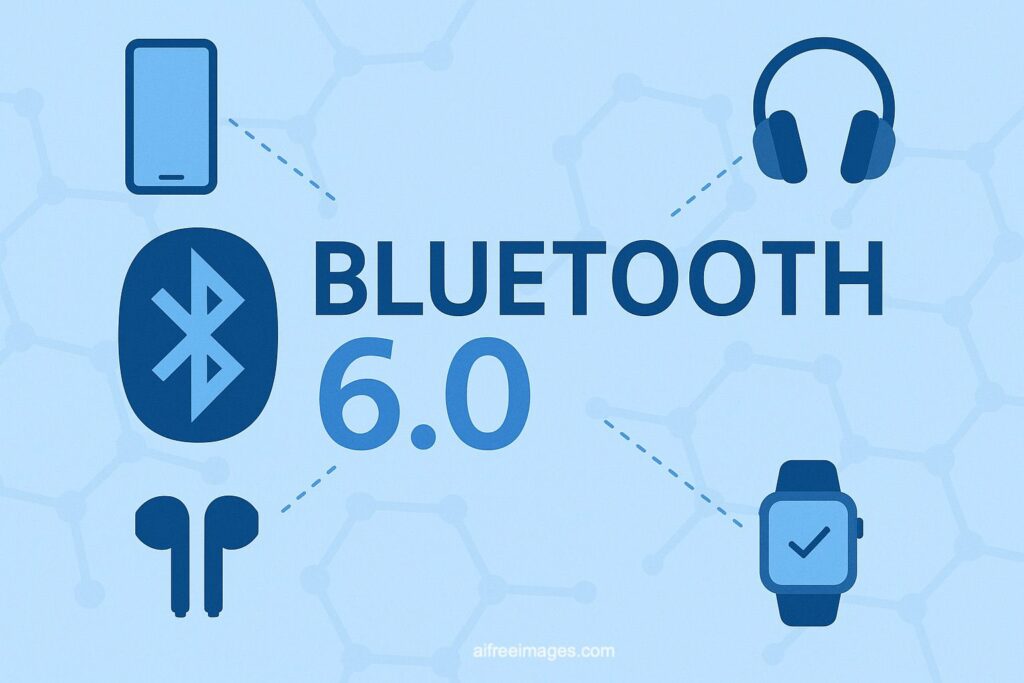Bluetooth 6.0 is here to redefine the wireless experience across multiple sectors, setting a new standard compared to version 5.3. Improvements span speed, energy efficiency, security, and mesh networking management, transforming everything from smart homes to automotive and connected healthcare.
The Evolution of Bluetooth: From Basic Transmission to a Hyperconnected Ecosystem
Since its introduction in 1999, Bluetooth has revolutionized wireless communication, evolving from basic audio connections to a core infrastructure for the Internet of Things (IoT). With each generational leap, the protocol has improved speed, range, efficiency, and its ability to handle complex networks. Bluetooth 6.0 takes another step forward, addressing the challenges of the new digital era.
Bluetooth Evolution Table
| Version | Release Year | Max Speed | Range | Energy Consumption | Main Features |
|---|---|---|---|---|---|
| 1.2 | 2003 | 1 Mbps | 10 m | High | Adaptive Frequency Hopping |
| 2.0 + EDR | 2004 | 3 Mbps | 10 m | Improved | Enhanced Data Rate (EDR) |
| 3.0 + HS | 2009 | 24 Mbps (HS) | 10 m | Similar | High Speed (Wi-Fi for large data) |
| 4.0 (LE) | 2010 | 1 Mbps (LE) | 50 m (LE) | Very low | Bluetooth Low Energy, IoT oriented |
| 5.0 | 2016 | 2 Mbps (LE) | 240 m (LR) | Low | Longer range, 2x speed, messages up to 255 bytes |
| 5.1 | 2019 | 2 Mbps (LE) | 240 m (LR) | Low | Real-time location, signal direction |
| 5.2 | 2020 | 2 Mbps (LE) | 240 m (LR) | Low | LE Isochronous Channels, LE Audio |
| 5.3 | 2021 | 2 Mbps (LE) | 240 m (LR) | Very low | Improved robustness, latency, and power consumption |
| 6.0 | 2025 | 4 Mbps (LE) | 300 m | Ultra low | <10 ms latency, advanced security, improved mesh |
Bluetooth 6.0 vs. Bluetooth 5.3: Technical Breakdown and Comparison
Data Transfer Speed
- Bluetooth 5.3: Up to 2 Mbps with Bluetooth Low Energy. Sufficient for most wearables, audio, and smart home devices.
- Bluetooth 6.0: Doubles the maximum speed to 4 Mbps LE, allowing for high-definition multichannel audio streaming, real-time biometric data sync, and low-resolution video streaming for smart security cameras.
Range and Signal Robustness
- Bluetooth 5.3: Maximum range of 240 meters in Long Range mode, though in practice it may be lower depending on the environment.
- Bluetooth 6.0: Up to 300 effective meters, with better interference management via advanced frequency hopping and adaptive modulation.
Latency and Response
- Bluetooth 5.3: Average latency of 20–30 ms. Adequate for most uses, but may fall short for gaming or industrial control.
- Bluetooth 6.0: Latency under 10 ms, essential for AR/VR experiences, wireless online gaming, or real-time machinery control.
Energy Efficiency
- Bluetooth 5.3: Improved energy management in sleep and periodic transmission modes.
- Bluetooth 6.0: Introduces “Ultra Low Power” modes and intelligent activity cycle management, extending battery life of wearables and sensors by up to 30% over the previous generation.
Security and Privacy
- Bluetooth 5.3: AES-CCM encryption, but with some limitations against sophisticated attacks.
- Bluetooth 6.0: Provides reinforced end-to-end encryption, multi-factor authentication, and active protection against man-in-the-middle and impersonation attacks using secure hardware elements.
Multipoint Connectivity and Mesh Networks
- Bluetooth 5.3: Allows multipoint connections but with limited synchronization; mesh networking is present but not optimized for large deployments.
- Bluetooth 6.0: True multipoint and scalable mesh, with hundreds of coordinated nodes and low latency, ideal for smart factories and connected cities.
Sector Use Cases: How Bluetooth 6.0 Is Transforming Industries
Automotive
- Example: Vehicles with multi-user profile integration, synchronized HD audio, keyless access, remote diagnostics, and real-time OTA (over-the-air) updates.
- Advantage: More connected devices per vehicle, without interference and with lower hacking risk.
Industrial IoT
- Example: Thousands of temperature, pressure, and presence sensors interconnected in a factory. Instant response to critical events and predictive diagnostics.
- Advantage: Stable mesh network, low latency, and minimal power consumption.
Consumer Electronics
- Example: True wireless earbuds with lag-free multichannel audio, AR glasses, smartwatches with real-time medical monitoring and smooth streaming.
- Advantage: Superior user experience and longer battery life.
Health and Medical Devices
- Example: Continuous monitoring of glucose, ECG, and other biometric parameters transmitted in real time to apps and hospital platforms.
- Advantage: Protected data and instant transfer, key for telemedicine and emergency response.
Smart Home
- Example: Lighting, thermostats, locks, and security cameras managed via a single Bluetooth mesh network, with voice commands and automated scenes.
- Advantage: Greater range, reliability, and security across the home ecosystem.
Conclusions and Outlook
Bluetooth 6.0 is a turning point in wireless connectivity. By doubling the speed, reducing latency, and strengthening security, this protocol lays the foundation for the next generation of smart devices, from wearables to connected cars and smart cities.
Its adoption will enable not only faster and safer experiences for users, but also new business models and applications that were previously unfeasible.
As manufacturers integrate Bluetooth 6.0, we’ll see a leap in interoperability, energy efficiency, and mass IoT deployments, consolidating Bluetooth as an essential pillar of 21st-century global connectivity.

